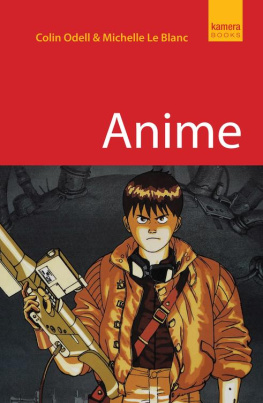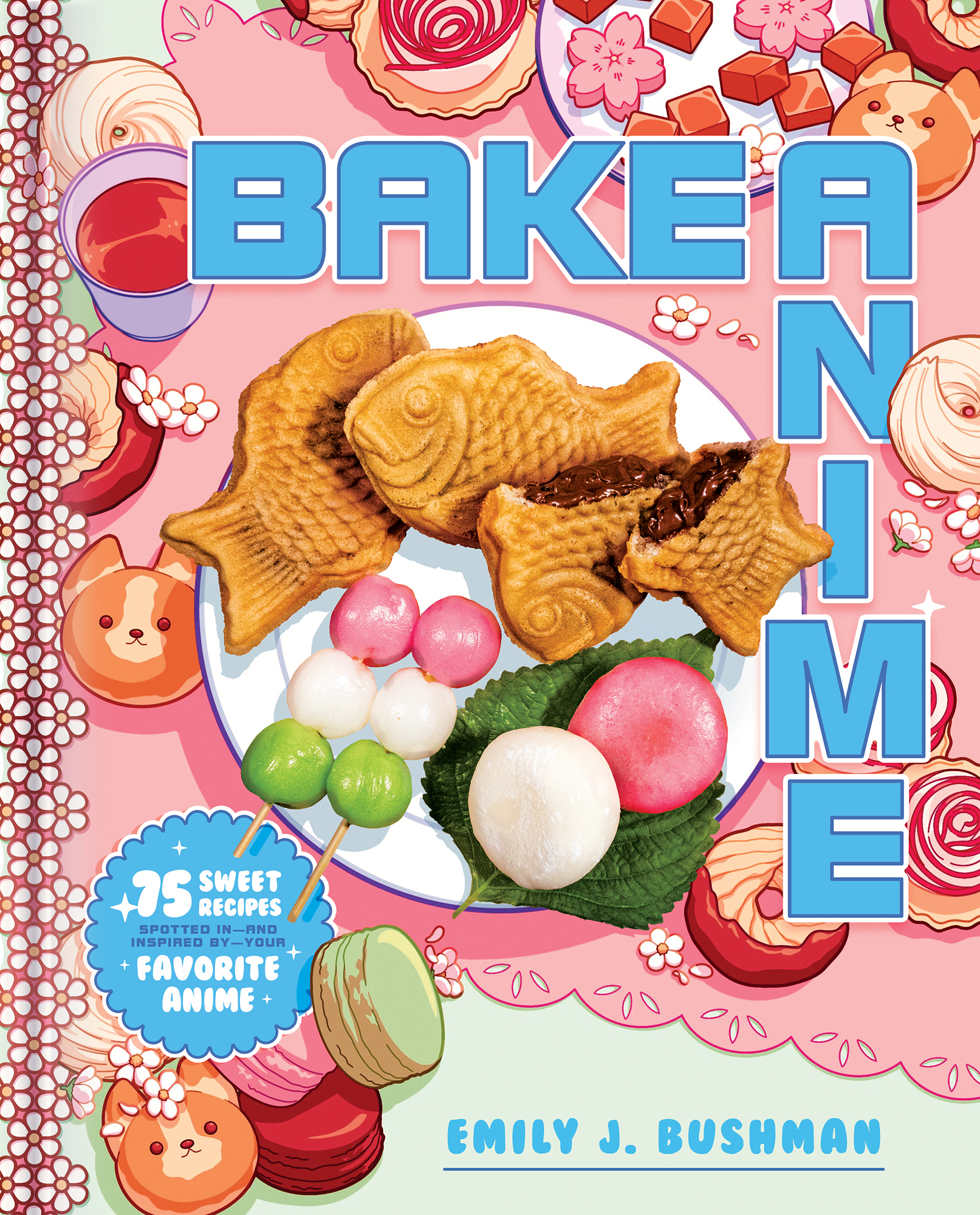Contents
Guide
Bake Anime
75 Sweet Recipes Spotted Inand Inspired byYour Favorite Anime
Emily J. Bushman
To the amazing food illustrators and animators in the industry, for always inspiring me.
To Mom, Dad, Lizzy, Bex, Sarah, and Hannah, for always believing in me.
And finally, to all my anime-loving friends, for giving me someone to cook for.
INTRODUCTION
S ilky-smooth whipped cream, luscious strawberries, and moist sponge cake. For me, this was my gateway drug into the enchanting world of anime desserts.
The first time I saw this perfect, delectable cake was during an episode of Ouran High School Host Club. In the scene, a character joyously munches his way through an entire picture-perfect strawberry shortcake.
Having grown up in America, the only strawberry shortcake Id ever known consisted of jammy strawberries on a stout, close-crumbed biscuit with a dollop of whipped cream. Perfectly acceptable. But anime strawberry shortcake, that was something else. The cute, layered symmetry promised perfection. The thick, fluffy whipped cream promised to melt on my tongue. The perfectly ripe strawberries promised a sweet bite with every forkful of cake. It was a visual masterpieceone I desperately longed to taste.
As a child, I was obsessed with anime. It offered a fun entry point into Japanese culture at large, a culture I loved and admired early on. I read manga religiously and watched whatever popped up on Toonami in sixth and seventh grades. It wasnt long before I asked my hairstylist to give me an anime haircut and begged my parents to take me out for Japanese food every night.
My father had lived in Japan for six months and left with a general disapproval of the food (he felt it was too bland), so he always vetoed my needy restaurant requests. My mother had lived in Japan for about a year, as well. She was concerned about my sudden and all-encompassing devotion to anime (she felt it was too risqu) and Japanese food, so she tried to distract me with bowls of Cinnamon Toast Crunch whenever I begged for sushi or teriyaki (it wasnt a bad trade-off). Of course, nothing really swayed me. For one of my birthdays, which fell during a holiday to Mexico that year, I insisted we had Japanese food for dinner. My parents commented on the absurdity of demanding Japanese food in Mexico City, but in the end, I got my gyoza.
As I grew older, my interests shifted from sampling food to making it. After a suggestion from the president of my college anime club, I started an anime food blog where I applied the cooking skills my mom and grandma taught me to learning Japanese cuisine. I threw myself into researching recipes. I wanted to know where dishes came from and what purpose they served in the anime they appeared in. I learned why Naruto ate so much ramen and why L from Death Note was obsessed with sweets. As I researched and tested recipes, I realized how food in anime was another way for audiences to understand Japanese culture (and these Japanese characters) more fully.
Desserts in particular show how Japanese history mingles with Japanese pop culture, so thats what I wanted to focus on in this book. Id like to take you on a journey to explore what desserts look and taste like in Japan, how they give nuance to the countrys culture, and, most important, how to make them yourself!
Before diving in, there are a few key things to know about Japanese sweets. Unlike American desserts, which can be decadent, rich, and sometimes over-the-top in their sweetness, Japanese desserts tend to be more refined, restrained, and, above all, aesthetically perfect. In order to learn more about why this is, I researched. There are only a few English-speaking sociologists and anthropologists who study the cultural whims of Japan, but youd better believe I tracked them down. Something I learned from these scholars was that Japanese food and its ingredients are intrinsically tied with Japanese history.
But wait, I can hear you saying, isnt all food tied with the history of its home country?
Good question, dear reader. If were going to be obvious, yes. But allow me to dig deeper before you roll your eyes! While the islands of Japan have many natural resources, the popular sugarcane plant is not one of them. As a result, most traditional Japanese sweets rely on alternative sweetening ingredients, like beans and sweet potatoes. This remained the status quo until sugar imports became common enough that more people could afford them. When this happened, Japanese sweets changed forever, as did the social significance of sugar. You see, even with increased imports, you had to be pretty well-off to afford imported sugar on the regular, so this placed nontraditional desserts on a bit of a pedestal for the average citizen for some time. This dynamic directly translates into anime. Desserts in anime can be symbolic of the economic circumstances of the characters who are (or arent) enjoying them.
One example is Setsuko from Grave of the Fireflies. The film follows the lives of two orphans, Setsuko and Seita, as they try to survive during World War II. Setsuko treasures a tin of Sakuma Drops , a popular candy of the time.
Sakuma Drops are a kind of dagashi, cheap multicolored hard candies comparable to penny candy in the US. Still available today, Sakuma Drops are sold in tin containers, partly to create an air of mystery regarding the treats inside.
In the film, Setsukos tin of Sakuma Drops becomes both a symbol of her hope for a return to normalcy and a reminder of what was lost to the war. The candy is also representative of the childrens economic status: Before the war, they could afford small luxuries. As the war progressed, they began to starve because they couldnt afford a cup of rice, let alone candy. Setsuko clings to the tin long after the drops are gone, prizing it above her other belongings. To see her cherish it casts the poverty the children experience and the loss of their childhood into sharp focus. In the end, the various ways in which the tin is interwoven throughout the films narrative show that the people who were hurt most by the war were those who were most innocenteveryday citizens who only wanted to enjoy the simple pleasures in life.
Sweets are also culturally symbolic in anime, either due to the time period in which the anime takes place, or because they appear outside their time period. For example, a modern character whos eating a traditional Japanese sweet like ohagi (sticky-sweet rice balls covered in bean paste) or manju (a soft dough exterior filled with sweet bean paste) might be doing so because that character indulges in old-fashioned food to represent a fondness for tradition.
My favorite example of this is from The Eccentric Family, an anime that follows the lives of a tanuki family living in modern Kyoto, with special attention to the adventures of third son Yasaburo.
Tanuki are animals that have a larger-than-life role in Japanese folktales. In folklore, their predominant skill involves transforming themselves (and plant leaves) into different people or objects for the purpose of mischief. However, as time has passed and people, places, and ideas modernized, belief in tanuki and their magical properties, as well as other folktales, has dwindled.
Though the family lives in modern Kyoto and assumes human guises most of the time, they live in a shrine and often eat traditional foods. In particular, Yasaburos mother, Tousen, snacks on yokan, a dessert made of red bean paste, agar, and sugar (youll find a recipe for yokan on ). Red bean paste was traditionally eaten by Japanese monks as a replacement for meat, since meat was outlawed for much of Japans history. As a result, quite a few desserts made to commemorate and celebrate important religious events contain red bean paste, which has a mild sweetness. Tousen snacking on yokan is a small nod to tradition, to a time when tanuki were regarded as having mythical properties. The juxtaposition of her eating yokan while instructing Yasaburo on how to navigate the modern world (and its modern problems) makes her choice of snack all the more impactful.










